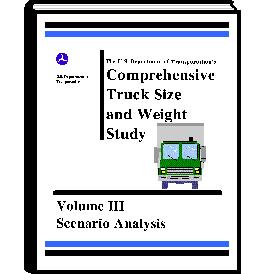
FHWA > Policy > Office of Transportation Policy Studies > TS&W
  TS&W Working PapersTS&W REPORT 1: SYNTHESIS OF TRUCK SIZE AND WEIGHT STUDIES AND ISSUES (March, 1995)Summary: This collection of 14 working papers provides a synthesis of available information on the broad range of topics related to truck size and weight policy. They present the findings of experts commissioned to search and compile the literature available on specific topics. They do not represent offical FHWA findings or conclusions.
TS&W REPORT 2: ANALYSIS OF THE TRUCK INVENTORY AND USE SURVEY FROM THE TRUCK SIZE AND WEIGHT PERSPECTIVE FOR TRUCKS WITH FIVE-AXLES OR MORE (February, 1996)Summary: This report provides factual information about and analysis of the U.S. freight hauling truck fleet, based on the Truck Inventory and Use Survey (TIUS) data bases from 1992 and 1987. The TIUS can be used to help understand the U.S. truck fleet make-up, size, uses, location, and type of commodities hauled at the national and regional levels. This information will be used to present a picture of the U.S. truck fleet and its uses as well as to evaluate the potential national/regional TS&W policy options. Download: Executive Summary (exsumrp2.pdf; size 136k); Report without appendices (rpt2_mai.pdf; size 811k); TS&W REPORT 3: TRUCK SIZE AND WEIGHT MODELING WORKSHOP (September,1995)Summary: The Federal Highway Administration sponsored an informal workshop on February 10, 1995, as part of the CTS&W Study. The objectives of the workshop were to discuss past work in modeling issues and identify new tools for TS&W analysis. Several experts gave presentations of their models and prior TS&W work which demonstrated different analytical approaches to the TS&W issue. Following the presentations, there were a group discussion of future research needs to support TS&W analysis. Download: Executive Summary (exsumrp3.pdf; size 26k); TS&W REPORT 4: TRUCK SIZE AND WEIGHT PERFORMANCE-BASED WORKSHOP (January, 1996)Summary: This is a summary of a workshop on performance-based regulations for truck size and weight, which was organized by the U.S. DOT's Federal Highway Administration. The workshop was held on June 30, 1995, at the Chrysler Center in Ann Arbor, Michigan, on the day after the Fourth International Symposium on Heavy Vehicle Weights & Dimensions. This summary is not a verbatim record of the proceedings. Rather, this account follows the discussion as it happened with explanations, definitions, and examples added for clarity. Download: Executive Summary (exsumrp4.pdf; size 46k); TS&W REPORT 5: WESTERN U.S.-CANADA CROSSBORDER CASE STUDY (December, 1995)Summary: This case study examines trucking across the western U.S.-Canada border and how it is influenced by truck size and weight (TS&W) regulations. Western border trucking differs from eastern border trucking in terms of the types of commodities being handled, the density of truck volumes, and the TS&W regulatory regimes arising from many grandfather exemptions and the resulting truck configurations. Also, the implications of a range of possible Federal TS&W policy initiatives on western border trucking are considered. Download: Executive Summary (exsumrp5.pdf; size 40k); TS&W REPORT 6: ANALYSIS OF THE TRUCK INVENTORY AND USE SURVEY FROM THE TRUCK SIZE AND WEIGHT PERSPECTIVE FOR TRUCKS WITH FOUR-AXLES OR LESS (October, 1996)Summary: This report provides factual information about and analysis of the U.S. freight hauling truck fleet, based on the Truck Inventory and Use Survey (TIUS) data bases from 1992 and 1987. The TIUS can be used to help understand the U.S. truck fleet make-up, size, uses, location, and type of commodities hauled at the national and regional levels. This information will be used to present a picture of the U.S. truck fleet and its uses as well as to evaluate the potential national/regional TS&W policy options. This report on the 4-axles or less truck fleet complements the TS&W Study Report #2 on the 5-axles or more commercial freight hauling fleet. Download: Executive Summary (exsumrp6.pdf; size 129k); Report without appendices (rpt6_mai.pdf; size 713k) |